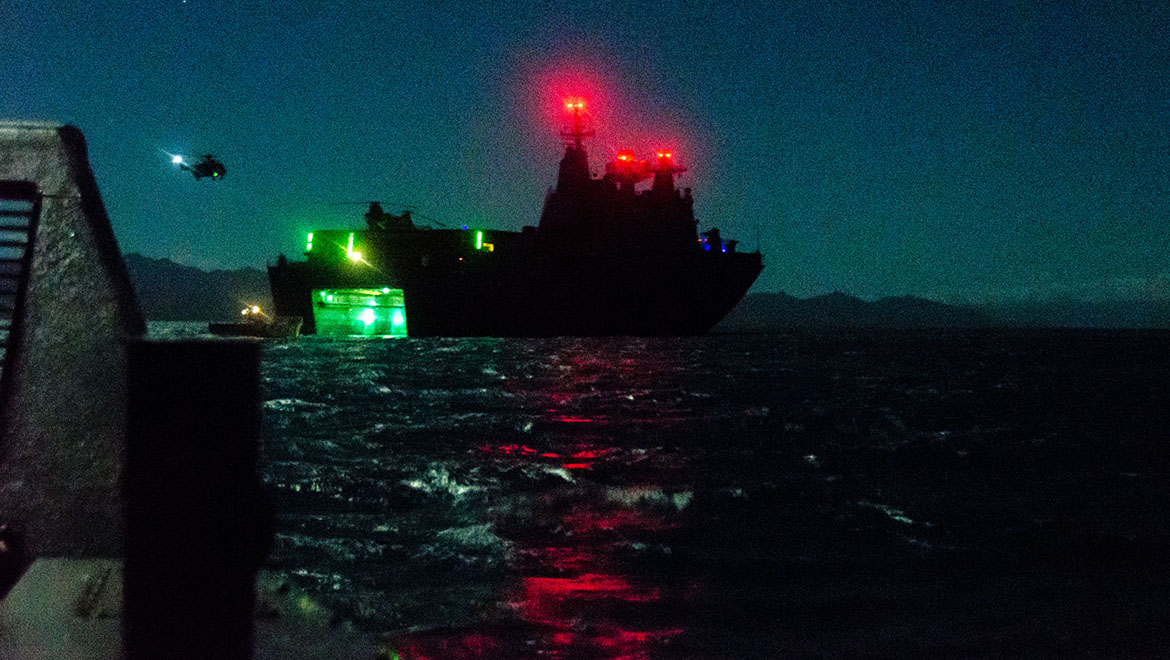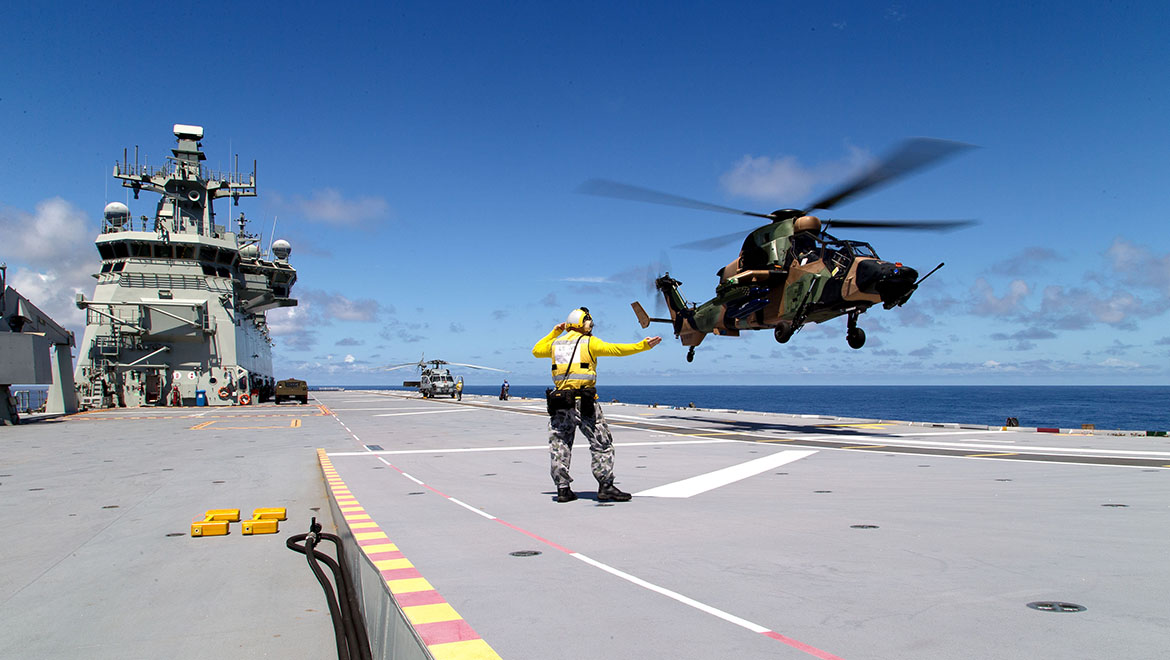This article originally appeared in the November 2018 magazine edition of Australian Aviation.

The development of the Australian Army’s amphibious capability took a major step forward recently when its 16 Brigade aviation component was certified for combined air operations from the Navy’s two Canberra class amphibious assault (LHD) vessels.
The certification came at the conclusion of a series of exercises off the Queensland coast near Bowen in early June involving HMAS Canberra and the Bay class landing ship dock (LSD), HMAS Choules.
The first of these, Exercise Sea Explorer, was designed to test Navy’s ability to deploy an amphibious force in a controlled environment in support of humanitarian assistance and disaster relief (HADR), non-combatant evacuation and joint combat operations, and involved the constant employment of aircraft and landing craft to move and support landing troops.
“We had a progression on the general amphibious side and the aviation progression,” Commander Forces Command (COMDFORCOMD), MAJGEN Fergus (Gus) McLachlan told sister publication ADBR.
“The ground combat element and the air combat element of the amphibious capability have both been in development for a couple of years.
“You’ll recall our 2nd Battalion of the Royal Australian Regiment (2RAR) based at Townsville was initially made a specialist amphibious capability in order to generate the specific competencies needed to operate from the ship and to do amphibious operations,” he added.
“Then the Army leadership team made the decision to rotate that ground combat element amongst the other battalions and the associated combined-arms capability of the Army, because we’re too small to have just one unit ready all the time.”
The certification is partly a ‘signing off’ by COMDFORCOMD as Army’s airworthiness authority, but there is also a Navy certification element as well.
“It’s always a combination of me and the fleet commander, and it’s done across a series of activities,” explained MAJGEN McLachlan.
“We confirm we can operate, we confirm we can do maintenance, and we confirm we can do flight ops just with personnel. We also confirm we can do flight ops with underslung heavy equipment.
“There was a dedicated checklist of competencies,” he added.
“At the end of that the Aviation Brigade Commander and the Amphibious Task Group Commander report back that, ‘yes, they have met all their competencies’, and we certify that as an operational capability.”
The joint operations certification comes after both the MRH 90 and the new CH-47F ‘Foxtrot’ Chinook of the Townsville-based 5 Aviation Regiment completed their own series of first of class flight trials (FOCFT) which studies each aircraft type’s flight envelope when operating around the ship in various wind conditions and sea states.

“The MRH-90 is our primary platform for the amphib ships,” MAJGEN McLachlan said.
“MRH has now been successfully integrated, and we’ve been operating off all the spots on the ship now for nearly two years.
“After first of class it’s then a process of learning how to operate aircraft from the ship,” he added.
“How many maintainers do we embark? What spares do we need? The information systems needed to record maintenance, data, the movement of ships, refuelling etc.”
After the successful integration of the MRH-90, the same activity needed to be conducted for Chinook, and how that aircraft interacts with the MRH.
“So now you’ve got two platforms,” MAJGEN McLachlan continued.

“You have to have two sets of spares and maintainers, and we need to work out how to move the two aircraft types around the deck and down the lift, and so on. So the workup process has been, as you would expect, quite thorough and detailed.
“At the end of that we do a combined tactical mission,” he added.
“Two different types of aircraft coming together, command and control, some slinging loads, some carrying personnel. So, it’s really making sure you build that ‘Lego wall’ of capability in good order, confirming that you’ve got each piece in place, and then adding the next level of complexity.
“It’s been great cooperation between Navy and Army,” MAJGEN McLachlan said. “What’s particularly pleasing is our young people are now just getting on with it and working together – this ‘jointery’ is becoming really quite powerful.
“I think that is for a whole range of reasons, a lot of them have been together on operations overseas, and a lot of the leaders have come through the ADFA generation, so they know each other. So I find it really pleasing that achievement on that joint capability is more advanced than we anticipated.”
MAJGEN McLachlan is very enthusiastic about the progress the MRH-90 in particular has made in recent years.
“I think there is still a perception about these helicopters being problematic,” he said. “And I’m not going to pretend their generation hasn’t been problematic.
“But MRH-90 is turning into a magnificent helicopter,” he added.
“I think it is truly world-class, and our rate of effort achievement is now such that we’re leading the world. In fact, in almost every case the time the pilots have behind the stick is at the leading edge for most complex helicopters in the world.”

While Exercise Hamel was the first opportunity to provide realistic tactical conditions to fully test the combined MRH-90 and CH-47F operations from the LHDs, these were also integrated with land-based Tiger ARH helicopters for integrated aviation battle group operations. The next step for Tiger is to integrate it with the LHDs as well.
“Tiger will be the focus of our next round of integration over the next 12 months,” MAJGEN McLachlan said.
“We have already fitted in some deck landings and handling. It has a high centre of gravity and a narrow undercarriage, so there are specific techniques required to manage it on the deck of a moving ship. But we haven’t done the underway stuff yet.

“Tiger has been in the pipeline longer than MRH but, again, it is a complex helicopter,” he added. “There are still commentators out there who fixate on the journey – I’m not going to apologise for the journey but, I can say that right now, we’re the best operators of these aircraft in the world.
“It is still more difficult to maintain than we would like, but it is now generating a world-class output as well. The broad history is what it is, but we are pretty good at operating these things now and that’s really pleasing. What we’re achieving is the equal of AH-64E ‘Echo’ and Tiger elsewhere, we’re achieving very similar availability and very similar levels of capability.”
There has also been some reported electro-magnetic interference between Tiger and the complex electronic equipment aboard the ships, although MAJGEN McLachlan is confident these can be overcome.
“There is a technical component to all of these evaluations,” he said.
“We need to make sure there are no mission issues – we don’t just want to stick it on there and hope for the best. Adding an armed helicopter obviously is another jump forward, but we already have some of those competencies with Romeo and other armed aircraft. It’s all doable, but it is a process we have to go through in a deliberate manner.
“I would hope, by Talisman Saber 2019, to have all three aircraft types operating off the LHDs as a confirmation of the capability.”
VIDEO – A Dept of Defence video showing HMAS Adelaide air operations during RIMPAC 2018.
This article originally appeared in the November 2018 magazine edition of Australian Aviation. To read more stories like this, subscribe here.















Mick C
says:That’s all good but unless we see a new Aviation Regt raised and an increase in Battlefield Helicopter numbers this will remain a part time capability. The ADF Battlefield Helicopter numbers are still the same as 40 years ago, 10-12 Chinooks, 40 MRH-90s v 40 odd Iroquois, 22 Tigers v 40 odd Kiowas. So the ADF does not have the capability to deploy an Aviation Force on the LHDs for any more than a few days and carry out other tasking at the same time.
TwinTiger
says:The certification for both the Chinook and the Taipan helicopters is welcomed as these are the primary users of the LHDs providing the bulk of humanitarian and offensive capability. However, I look forward to the future certification of the Tigers in 2019 which will provide a physcological ‘pointy end’ of the stick to any Amphibious force.
PAUL
says:OK so it has a Ski Jump …F35B?…
Black Hawk fan
says:Mick, Seat numbers. Hueys could carry 10. MRH can carry 20. I can’t remember exact numbers of each but the hueys were also configured to bushranger gunships. We can lift far more now than 40 years ago. On top of this we have less infantry and artillery than we did 40 years ago so why do we need extra seats and lift? Paul, we don’t need it. Leave the LHD for its purpose, to move troops around.